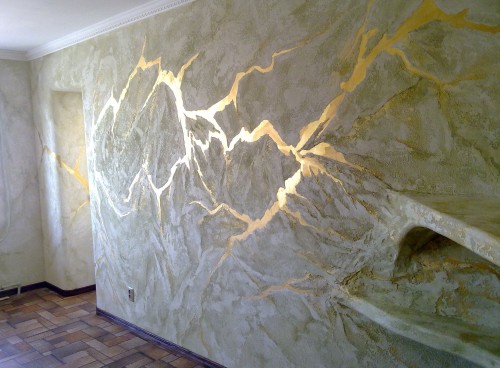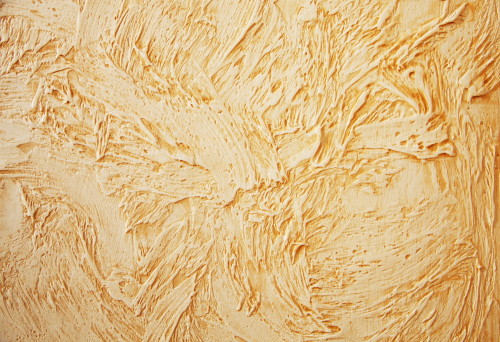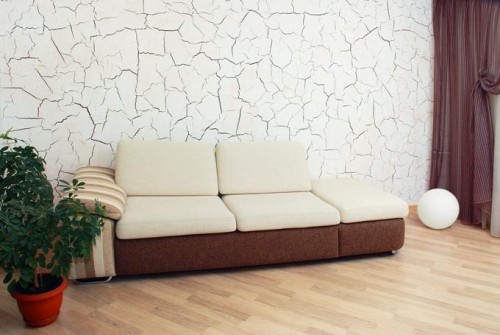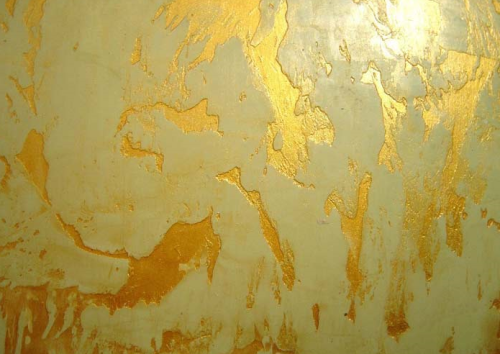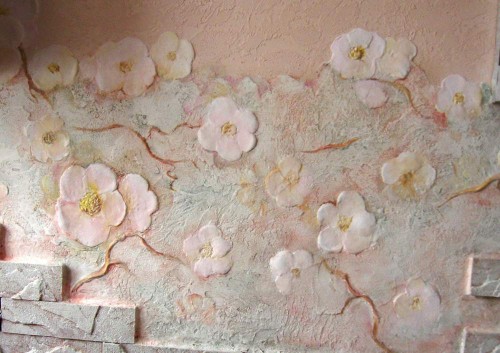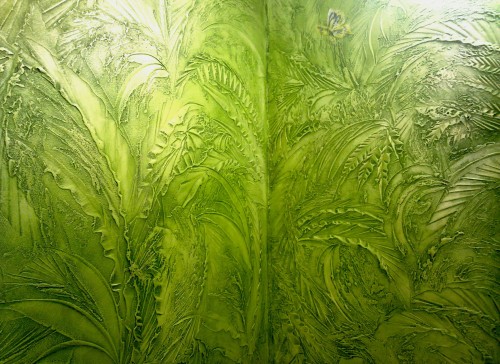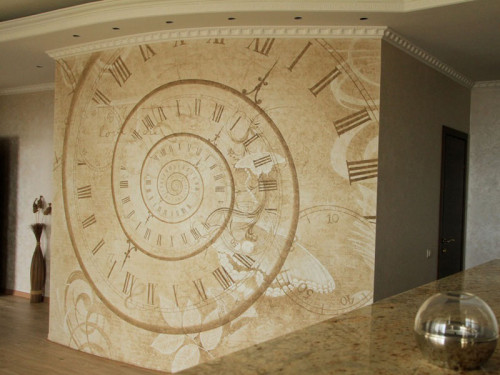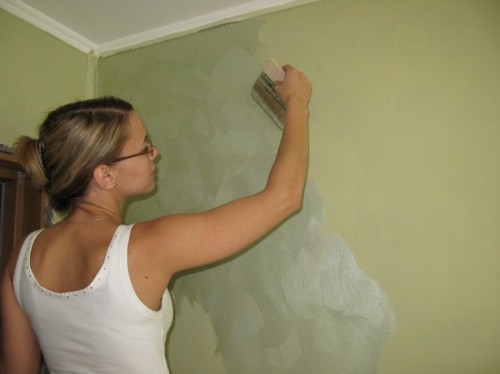For many years now, the plaster is used in construction not only as a material for alignment of walls, but also as a means of stylistic design of the premises. Special decorative plaster is the widest choice of the possibilities of wall decoration by the most diverse ways. In order to give the surfaces completed, the material is often painted in various shades. In this article we will talk about the features of painting plaster.
Content
What is the decorative plaster
Types of plaster depending on the component composition
- Mineral plaster - material created on the basis of minerals: lime or cement. The dry mixture can be breeding to the desired consistency of ordinary water, and this composition is used for a wide variety of purposes. Mineral plaster does not have sufficient elasticity and does not tolerate vibratory loads. If the building, for example, is located near the railway, from frequent vibrations the coating on the walls can go cracks. The most important advantage of such a composition can be considered its low cost.
- Silicate plaster is based on liquid potassium glass. This material also does not tolerate vibrations, although in general is stronger and reliable than the previous option. By the way, the silicate plaster is practically not polluted.
- Acrylic composition can be used on various surfaces both in and outside buildings. Such plaster is based on the aqueous dispersion of acrylic resins. The material has a number of advantages: it can be used to clamp walls in rooms with high humidity, it is not exposed to sharp temperature differences, well cleaned from dirt, and also dries quickly after applying. Virtually any surface can be handled with decorative acrylic plasters, while not worrying about careful preparations.
- Silicone plaster today is considered the highest quality material, but it is worth it more expensive than its analogues. This substance includes special binding polymers that make it very plastic and waterproof. With silicone plaster, it is very easy to work, for its applying on the wall, special skills and skills are required. The dried surface is obtained smooth, smooth and dense, not subject to deformations, not cracking under the influence of vibration loads, and is also easily cleaned by contamination.
Selecting the material for work, rely on your financial capabilities, as well as on the features of the room in which you plan to finish. For example, it is better to use acrylic plaster for facing the kitchen walls, which will easily transfer increased humidity and temperature differences. Silicone plaster is suitable for any premises, but not everyone can afford a similar material due to its high cost.
Classification of decorative plaes for the size of the filler
Particles that are part of the material allow you to create any relief on the wall. The larger the filler, the terrain it turns out the treated surface. In addition, on the size of the particles that are part of the plaster, the material consumption will be dependent directly. Textured plaster with large filler may need much more than substances with small particles. This feature should be considered, calculating the desired amount of material.
Tip: For extensive rooms, it is better to use stucco with large particles - so a relief surface can be easily seen from afar. But in small rooms, the surface texture is easy to see even if the walls with a fine filler will be applied.
Classification of plastekers in composition and appearance
Depending on which components are the material, as well as on how the wall will look at the final form, there are 3 main types of decorative plaster:
- Structural plaster is a mass with an inhomogeneous consistency. Such material has in its composition various fillers, which, after applying a substance on the wall, make it possible to create a relief grain surface. As a filler, solid particles are often performed, for example, small stones, marble crumb, quartz pieces, wood fibers, etc. As a binder, artificial latexes or potassium silicate, and solvents that are part of can be like water, so And on an organic basis. If the structural plaster is used in the facing of the inner walls, it is better to select the material on a water basis, since it is harmless and does not have a sharp smell. If you use plaster with organic solvents in trim, then people are better not to visit such a room for some time. By the way, the structural compositions are very simple in the work, can be applied to the wall with practically any tools, possess high plasticity. It should also be noted that such plasters are sold in the finished form, they do not need to be breeding to a suitable consistency independently.
- Textural plasters, although used to create on the walls of the embossed surface, in its component composition may not contain additional large particles. They are almost homogeneous mass, which is applied to the surface with a variety of tools and thanks to it they also form the desired texture or pattern. How the final result will look in this case, does not depend so much from plaster, as from the tools used in the work. Most textural plasters are made on the basis of lime flour, into which fillers are sometimes added in the form of stone crumbs or various fibers.
- Venetian plaster is a composition designed to create on the wall imitation of a marble surface. Such a plaster is a translucent mass produced from marble flour, an aqueous emulsion and hated lime. Products are implemented in the finished form, it is not necessary to dilute it yourself. The main requirement when working with Venetian plaster: The basis before it is applied should be almost perfectly aligned. The dried composition will later be painted in any shade. Although such material is quite expensive, it has high quality and many advantages: waterproof, environmental friendly, fire safety, high strength, beautiful and prestigious views.
Decorative plaster: Advantages and Disadvantages
As with any finishing material, decorative plaster has its pros and cons. The advantages of such a material include the following characteristics:
- Long service life. Most decorative plasters are strong enough, they are not damaged as a result of mechanical effects and temperature differences.
- Beauty and a neat look, which is achieved due to the absence of seams on the coating.
- The plasticity of the material that makes it possible to process even the most hard-to-reach places.
- Ecology and harmlessness. Decorative plaster are produced on the basis of environmentally friendly and non-toxic materials.
- Ability to create a variety of drawings and textures on the surface of the walls. In addition, decorative plaster can be painted in any shade, you can combine an unlimited number of colors on one surface. Such a choice of shades is unlikely to provide any other finishing material.
- The versatility of decorative plaster allows you to use it in any room and design.
- Easy to care. Most of the compositions are easily cleaned by dirt cloth. When washing plaster, you can also use different cleaning products.
The shortage of such coating can be attributed to:
- High cost, which is not for everyone to pocket. However, invested money is high quality, and thanks to the reliability and long service life, the costs of plaster will be accumulated with interest.
- In some cases, the help of specialists will need for cladding of the walls, and these are additional spending. Although many copes with such work independently.
Decorative plaster, photo:
Painting of decorative plaster
Calling material
In a simple way to paint the plaster in the desired shade and get a smooth and homogeneous color at the same time. In the process of composure, the dye is added to the composition of the finishing material and is mixed to homogeneity using a special mixer. This procedure can be performed independently, but you can resort to the help of specialists who paint the products you buy in the desired shade.
Types of paints for decorative plaster
Instead of adding pigments to the ground, you can make painting walls by plaster. Interior or facade paints created on the basis of water or organic solvents are used as working material. Color When painting plaster, you can choose any. If there is no dye of the desired shade on sale, you can always play with a variety of pigment combinations.
The calculation of the desired amount of material is carried out very simply. First of all, you need to measure the overall area of \u200b\u200bthe walls, multiplying the height and width of the surface. Then the area of \u200b\u200bwindow and door openings should be measured, and then deduct the value from the total area. Having learned the desired value, you can calculate the desired amount of material. As a rule, manufacturers indicate the packages of their goods information about the approximate consumption of paint. It is worth adding that the surface treatment with a pronounced relief will take more material than the smooth wall of the same area. The paint should be purchased with a reserve, which should be about 15% of the total amount of material.
Painting of decorative plaster: instruction
To carry out such work, first of all, you need to stock the necessary tools. You will need the following:
- paint tray;
- roller and brushes of different sizes;
- cord from Capron, which is put on the bucket with paint.
Painting plaster is carried out using a roller, brush or special mitten. It is advisable to prepare tools of different sizes so that you have the opportunity to qualitatively paint both large areas and hard-to-reach places. The process of painting decorative plaster consists of such stages:
- Register the plastered surface by any color only if the wall is completely dried after all previous works. Stucco, as a rule, dries over 8-48 hours, depending on the type of material and temperature conditions of the room. In order to keep the paint better, especially if there is a risk of sickling small fragments of plaster, it is desirable to cover the wall with a ground composition and give the surface to dry completely.
- Getting Started with paint, it is necessary to protect all the unwinted surfaces from splashing. If there is no possibility to carry out the furniture from the room, it needs to be completely covered with a large cut of a polyethylene film. It is also desirable to protect the window of the window, doors and gender. If the work is carried out outside the building, it is enough to cover the windows and, if necessary, a garden track.
- When preparatory work is finished, you can start painting. First, open the jar with paint and thoroughly stir the composition. After that, choose a suitable brush and apply paint on the wall with wide strokes. Strokes It is advisable to do in different directions, so that in the end it turned out a smooth shade. First, perform some horizontal movements with a brush, then grow in the strokes in the vertical direction.
- In the process of work, periodically stirrate the paint to the brush that you apply the material on the wall. Thus, the paint will remain homogeneous in color and consistency.
- Instead of a brush, you can work roller. The process of staining walls by this tool is almost no different from the actions described above. First, plunge the roller in the coloring composition and ride it about the studded tray plate, to remove excess material. Then paint the wall with vertical movements, moving down and back. During the work, try to achieve a uniform shade, overlapping each new strip about 4-5 cm on top of the previous one. With each new movement, try to press the roller a little stronger to achieve a uniform layer.
- The paint can be applied in a 1 layer, but it is better to paint the wall again, so that the shade turned out to be more even.
The most beautiful and monophonic surface can be obtained if you first treat the wall with a wide brush, growing paint, and after covering the surface by another layer of material using a roller in the work.
The embossed structure can be painted in one hue, but more winning will look at the painting of plaster in two colors. In a similar case, the deepening and protrusions on the surface will contrasted with each other, visually reinforcing the effect of relief. To paint the wall in a similar way, you first need to apply a basic tint of the roller. Then, when the paint is completely dry, protrusions and irregularities on the wall should be covered with a different color with the brush. It is not necessary to press a strong tool to the tool, so that the second paint layer did not get into the recess. This coloring technique is called a dry brush method.
A more effectively wall will look if instead of ordinary contrast paint use material with the effect of gilding, silver or bronze. Such dyes with the effect of metal shine are conveniently applying a special mitten or all the same dry brush. Note that such material cannot be used in large quantities. During operation, it will only be enough to touch the surface with a brush moistened in a brilliant paint - the final result will look expensive, luxurious and exquisite. If you move with the amount of gilding, there is a risk of achieving a vulgar and tasteless effect. It is possible to consider all the subtleties of the painting of decorative plaster in more detail on the video on the Internet.
The popular way of decoration of the walls today is the finish with the "Coroed" effect. When painting, the "Coroed" plaster you need to use a short pile roller. Working like a tool, you will handle paint only the outer surface of the wall, and all the grooves will remain unpainted and will be well visible on a general background. To achieve greater contrast, you can pre-toll the plaster composition with the desired tint.
Painting of decorative plaster with a pronounced relief need to be carried out with some features. Initially, the coloring makeup should treat all the protruding parts, give them to completely dry, and already after painting smooth plots. If you open the paint the entire surface, poorly fixed particles of textured material will move away from the wall and stick to the sections with a smooth texture. Note that when repeatedly staining the wall, the rule described above is no longer necessary.
To make the surface of the wall matte, the dry paint can be covered on top of the beeswax.


